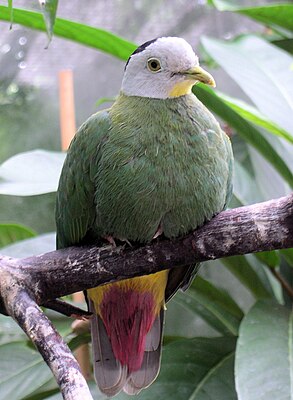Black-necked fruit pigeon
| Black-necked fruit pigeon | ||||||||||
|---|---|---|---|---|---|---|---|---|---|---|

Black-necked fruit pigeon, male |
||||||||||
| Systematics | ||||||||||
|
||||||||||
| Scientific name | ||||||||||
| Ptilinopus melanospilus | ||||||||||
| ( Salvadori , 1875) |
The black-necked fruit pigeon ( Ptilinopus melanospilus ), sometimes also called the black-capped fruit pigeon , is a species of bird in the pigeon family . It belongs to the downy pigeons and is distributed with up to six subspecies in the Southeast Asian island world.
Appearance
The size of the pigeon varies, depending on the subspecies, from smaller than laughing to the size of city pigeons . It is similar to the other types of pigeons in the genus of the downy pigeons . There is a pronounced gender dimorphism .
The male's head is silver-white, with a black spot from the back of the head to the nape of the neck. The lower abdomen and tail-coverts are golden yellow, the longer tail coverts carmine-red. The rest of the plumage is dark green with a golden-bronze shimmer. The females are dark green on the whole, with a gray tinge on the chin, neck and chest.
distribution and habitat
The distribution area of the black-necked fruit pigeon includes Sumatra , Java , the Lesser Sunda Islands from Bali to Alor , Celebes , Palawan , the southern Philippines, Wallacea and Borneo .
Keeping in human care
The first keeping in Europe took place in 1865 and 1872 at London Zoo . Due to the complex housing and food conditions, there are only a few zoos and private owners who deal with keeping the black-necked fruit pigeon.
The species is currently kept in Germany by Zoo Berlin , Zoo Frankfurt and Viernheim Bird Park . In addition, there are 16 other zoos in Europe ( EAZA area ) that keep the species.
The European fruit pigeon project shows the following offspring statistics for the last few years:
| year | Number of breeders (private + zoos) | Number of participating zoos, bird parks, etc. | Offspring (m / f / u) |
| 2010 | 15th | 2: Zoo Pilsen , Prague Zoo | 23/21/5 |
| 2011 | 11 | 1: Pilsen Zoo | 14/16/2 |
| 2012 | 14th | 3: Zoo Berlin , Zoo Pilsen , Prague Zoo | 24/18/1 |
Subspecies
There are currently five subspecies:
- Ptilinopus melanospilus bangueyensis ( Meyer, A. , 1891) This subspecies occurs in the south of the Philippines and the islands in the north of Borneo .
- Ptilinopus melanospilus xanthorrhous ( Salvadori , 1875) This subspecies is distributed on the Talaud Islands , Sangihe Islands and the Doi Islands north of the Moluccas .
- Ptilinopus melanospilus melanospilus ( Salvadori , 1875) The nominate form is present on Sulawesi and the islands to the northeast.
- Ptilinopus melanospilus chrysorrhous ( Salvadori , 1875) This subspecies is common in the Banggai Islands , the Sula Islands and the southern part of the Moluccas .
- Ptilinopus melanospilus melanauchen ( Salvadori , 1875) This subspecies occurs on Java , Bali to Alor , the island of Matasiri and the Kangean islands , as well as the southern islands of Sulawesis.
Web links
- Ptilinopus melanospilus inthe IUCN Red List of Threatened Species 2013.2. Listed by: BirdLife International, 2012. Retrieved January 1, 2014.
- BirdLife International: Species Factsheet - Black-naped Fruit-dove ( Ptilinopus melanospilus ) . Retrieved January 12, 2014.
- Videos, photos and sound recordings of Black-naped Fruit-dove (Ptilinopus melanospila) in the Internet Bird Collection
- Black-capped fruit pigeon ( Ptilinopus melanospilus ) at Avibase; accessed on January 12, 2014.
- Ptilinopus melanospilus in the Integrated Taxonomic Information System (ITIS). Retrieved January 12, 2014.
- xeno-canto: Sound recordings - Black-naped Fruit-dove ( Ptilinopus melanospilus )
- Website of the European fruit pigeon project
- Black-naped fruit dove ( Ptilinopus melanospila ) on zootierliste.de, Accessed on 1 January 2014
supporting documents
literature
- David Gibbs, Eustace Barnes and John Cox: A Guide To The Pigeons and Doves Of The World , Yale University Press, New Haven and London 2001, ISBN 0-300-07886-2 .
- Alois Münst and Josef Wolters: Species in color - Volume 1: Pigeons - the species of wild pigeons , Karin Wolters publishing house, Bottrop 1999, ISBN 3-9801504-9-6 .
- Peter Pestel: keeping, care and breeding of the black-necked pigeon (Ptilinopus melanospila) , VZE Vogelwelt, 56th year, 2011, issue 2, p. 37f.
- Heinz-Sigurd Raethel : wild pigeons. Keeping, care and breeding. Verlag Eugen Ulmer, Stuttgart 1980, ISBN 3-8001-7053-1 .
- Gerhard Rösler: The wild pigeons of the earth - free life, keeping and breeding , Verlag M. & H. Schaper, Alfeld Hannover 1996, ISBN 3-7944-0184-0 .
- Tommaso Salvadori: Intorno a due collezioni di uccello di Celebes inviate al Museo Civico di Genova dal Dr O. Beccari e dal Sig. A. Bruijn . In: Annali del Museo civico di storia naturale di Genova (= 1 ). tape 7 , 1875, p. 641–681 ( online [accessed January 21, 2014]).
- Adolf Bernhard Meyer: About some pigeons from Borneo and the Philippines . In: Journal of Ornithology . tape 39 , no. 193 , 1891, pp. 641–681 ( online [accessed January 21, 2014]).
Individual evidence
- ↑ Rösler, p. 286
- ↑ a b c Raethel, p. 189
- ^ Gibbs, Barnes and Cox, p. 516
- ^ Pestel, page 27
- ↑ a b Black-necked fruit pigeon on zoo animal list
- ↑ breeding statistics fruchttaubenprojekt.eu
- ^ IOC World Bird List pigeons
- ^ Adolf Bernhard Meyer, pp. 41 & 70
- ↑ a b c Tommaso Salvadori, p. 671
- ^ Tommaso Salvadori, p. 670
